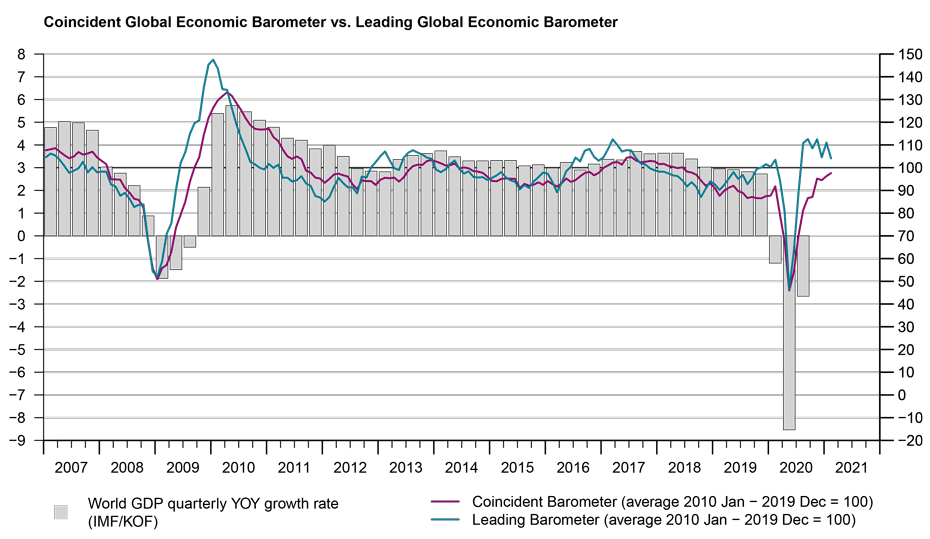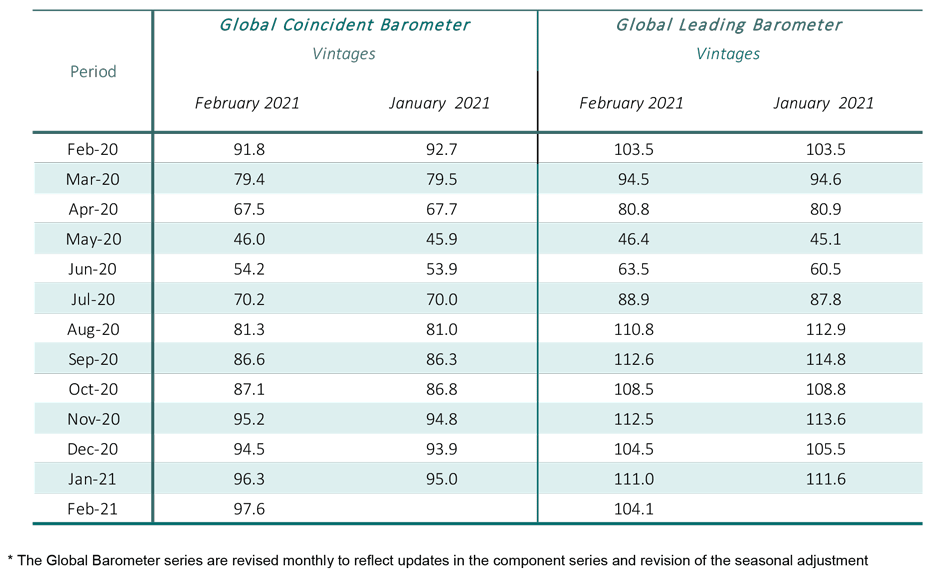The race between the pandemic and immunization programmes
The February Global Economic Barometer results reflect the uncertainty of the rate of recovery of global economic activity in the first half of 2021 and the noticeable heterogeneity between the regions. The Coincident Barometer increases with less intensity than in the previous month, while the Leading Barometer is moving towards the approximately neutral level.
The Coincident Global Barometer increases by 1.3 points in February, from 96.3 to 97.6 points. The Leading Global Barometer falls 6.9 points, to 104.1 points. On the Coincident time frame, only the Asia, Pacific and Africa region developed favourably, while Europe and the Western Hemisphere contribute negatively to the result. For the Leading Barometer, the Western Hemisphere moves in the opposite direction than the other regions with a slight positive contribution to the aggregated result.
“Despite the increased stringency measures around the world in the latest two months, the economy, except for services, appears to be doing relatively well. Hence, the economy seems to have learned as of how to cope with these more stringent measures”, concludes Jan-Egbert Sturm, director of KOF Swiss Economic Institute.
Coincident Barometer – regions and sectors
The Asia, Pacific, and Africa region contributes 2.1 points to the rise in the Coincident Barometer in February, while the Western Hemisphere and Europe contribute with -0.5 and -0.3 points negatively, respectively. The difficulties encountered in the immunization campaigns occurring alongside the arrival of even more infectious variants of COVID-19 may have influenced the poor result of the latter two regions. The graph below illustrates the contribution of each region to the deviation of the Coincident Barometer from the historical average of 100 points.
Among the five sectors, Retail and Wholesale Trade, Services, and the set of variables reflecting the aggregated development of economies (Overall Economic Development) contribute positively to the result, whereas the remaining sectors move in the opposite direction. The strongest positive contribution comes from Retail and Wholesale Trade and the strongest negative contribution from Industry.
Leading Barometer – regions and sectors
The Leading Global Barometer leads the world economic growth rate cycle by three to six months on average. In February, the Asia, Pacific, and Africa region is responsible for 70% of the decrease in the aggregate indicator, whilst Europe contributes negatively 2.2 points, or 32%. The results reflect the uncertainties as to each country’s rate of recovery in the face of the challenge of global immunization and control of the pandemic. The Western Hemisphere contributes in the opposite direction to the other regions, but now with a slightly positive result for this month.
All Sectorial Leading Barometer decreased in February. The set of variables reflecting the aggregated development of economies (Overall Economic Development) and Industry remain the most optimistic groups (with 111.1 and 110.0 points, respectively), despite the latter having recorded the largest fall among the sectors this month. The second largest drop among the sectorial Barometers came from the Services sector, which remains yet to recover from its pandemic losses.
In February, all the Leading sectorial Barometers contribute negatively to the aggregate result. Industry contributes with 4.6 points to the decrease in the general indicator. The other sectors contribute between 0.2 and 0.8 points each to the aggregate result.
The full press release with table and graphs can be found Download here (PDF, 523 KB).
More information on the Global Economic Barometers can be found here.
The Global Economic Barometers
The Global Economic Barometers are a system of indicators enabling timely analysis of global economic development. They represent a collaboration between the KOF Swiss Economic Institute of the ETH Zurich in Switzerland and Fundação Getulio Vargas (FGV), based in Rio de Janeiro, Brazil. The system consists of two composite indicators, the Coincident Barometer and the Leading Barometer. The Coincident Barometer reflects the current state of economic activity, while the Leading Barometer provides a cyclical signal roughly six months ahead of current economic developments.
The two Barometers comprise the results of economic tendency surveys conducted in more than 50 countries with the aim of achieving the broadest possible global coverage. The advantages of economic tendency surveys are that their results are usually readily available and are not substantially revised after first publication.
The Coincident Barometer includes more than 1,000 different time series, while the Leading Barometer consists of over 600 time series. Cross-correlation analysis is used to decide which individual time series are included in the barometers. This involves correlating the individual time series with a reference series. The reference series used is the year-on-year growth rate of global gross domestic product (GDP), where the individual national GDPs are aggregated at purchasing power parity to form global GDP. A time series is only included in a Barometer if it shows a sufficiently high correlation and a suitable synchronization or lead with the reference series. The time period used for this correlation analysis currently runs from January 2010 to December 2019.
The series of the two Barometers are revised each month at publication and are standardized to have a mean of 100 and a standard deviation of 10 for the 10-year period previous to the most recent observations.

